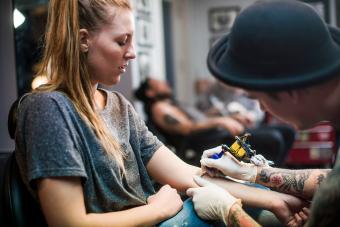
Tattoos and Infection Control
Infection control is a serious part of the tattoo process. In fact, it could be seen as the most important part of all. Unless proper sanitary procedures are followed, both client and artist are at risk of contracting serious illnesses that could actually be life threatening. This includes staph infections, HIV, and hepatitis.
Infection Control Practices for Artists
You owe it both to your clients and yourself to follow infection control safety protocols every single time you create a tattoo.
Preparation
- Cover all tattoo equipment surfaces with a protective plastic drape to catch any body fluids that are released during the tattoo.
- Thoroughly wash your hands, inspect yourself for cuts/scrapes, and put on a fresh pair of surgical gloves.
- Wear a surgical mask to help prevent inhalation of airborne blood.
- Shave and disinfect the area where the client's tattoo will be placed, being sure to properly dispose of the razor. It wouldn't hurt to change to a fresh pair of gloves at this point, either.
- Use only tattoo equipment that has been properly sterilized in an autoclave or ultrasonic disinfection unit. All equipment should be left in their dated and sealed bags until you are ready to use them on your next client.
- Open the sterile bags and remove the equipment just prior to beginning the tattoo.
- Be sure you have a sterile cup filled with a disinfectant solution ready to receive needles, etc., used during the process.
During the Tattoo

- Avoid cross-contamination while you work. This means being careful not to touch any unsterile equipment or surfaces directly with your gloves, such as when refilling pigment caps, scratching your face, etc, and then touch your sterile equipment or client. You can actually transfer germs this way, even though you've followed all the other protocols. If you find you've touched something unsterile, change to a fresh pair of gloves before you proceed. If you touched your sterile equipment, switch to new sterilized equipment.
- Check your gloves frequently to make sure they haven't developed any pin holes or tears while you're using the tattoo machine.
- When changing colors, it's safer to use a fresh, sterilized tube rather than rinsing the current tube you're using.
- Keep a waste can lined with a trash bag near your feet so you can safely toss any disposable wipes, etc.
- If you use a skin disinfectant to wipe away blood from the client's skin during the tattoo, spray the disinfectant into the tissue first rather than spraying it directly onto the wounds. This will decrease the chances of the spray mixed with blood from blowing back in your face.
When Tattooing is Finished
Keep focused on what you're doing so you don't accidentally contaminate yourself, or anyone else.
- Put on fresh gloves, properly disinfect and bandage the client.
- Properly discard the used gloves, wash your hands and give the client aftercare instructions, both verbal and written.
- Put on fresh gloves and begin the process of disinfecting machines, and all equipment. Be sure that every reusable item is run through the autoclave or ultrasonic unit, and leave all disinfected items in sealed/dated bags until next use.
- Double bag and discard all hazardous disposable materials such as drop clothes, gloves, masks, wipes, etc.
- Clean and disinfect all surfaces, including the chair, tables surfaces, trash can and floor, working from top to bottom.
- Wash your hands again when finished.
Tattoo Aftercare for Clients

The fight for infection control doesn't end when you leave the tattoo shop with your new body art. Far from it. No matter how conscientious your artist has been, you now have thousands of tiny open wounds in your skin that will require diligent care throughout the healing period to keep them free from infection.
- Always wash your hands before touching your fresh tattoo.
- Keep the area clean and disinfected by gently washing it with antibacterial soap two or three times each day. Using clean fingers is much more gentle than scrubbing the tattoo with a sponge or cloth.
- Fresh air is good for accelerating healing, but if your tattoo is still bleeding, be sure to rebandage it.
- Apply a topical antibiotic cream, if recommended in the aftercare instructions you received from your artist.
- Watch for signs of infection, including increased redness, pain, swelling, heat, or a foul smell coming from the tattoo. If you notice one or more of these symptoms, contact your doctor immediately.
Conclusion
Infection control is a team effort between the client, the artist, and the tattoo shop involved. Everyone must do his or her part to keep the art of tattooing safe for everyone.







